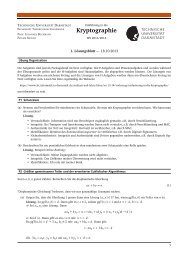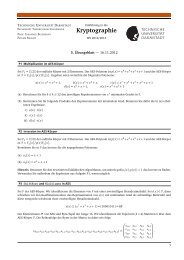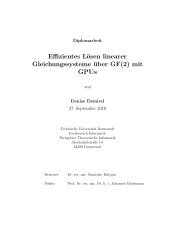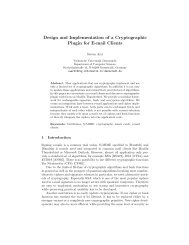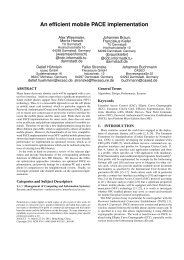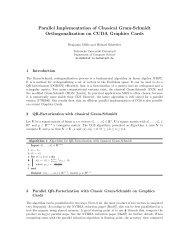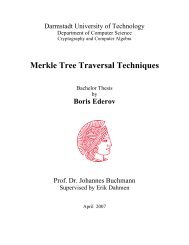Lattice Basis Reduction in Infinity Norm - Technische Universität ...
Lattice Basis Reduction in Infinity Norm - Technische Universität ...
Lattice Basis Reduction in Infinity Norm - Technische Universität ...
Create successful ePaper yourself
Turn your PDF publications into a flip-book with our unique Google optimized e-Paper software.
Figure 1: First Successive M<strong>in</strong>imum<br />
An example of a first successive m<strong>in</strong>imum λ1(L(a, b)) = x is the figure<br />
above.<br />
S<strong>in</strong>ce for every lattice L ⊆ R n � x �∞ ≤ � x �2 ≤ √ m � x �∞ for all<br />
x ∈ R n , it holds for the successive m<strong>in</strong>ima that<br />
λ1,∞(L) ≤ λ1,2(L) ≤ √ mλ1,∞(L)<br />
Theorem 2.9. For each lattice L ⊆ R n of rank m, � L �∞ ≤ (det L) 1<br />
m<br />
2.3 Distance Functions<br />
The term ”Distance Function” was <strong>in</strong>tegrated <strong>in</strong>to the lattice reduction theory<br />
by Lovász and Scarf.<br />
Def<strong>in</strong>ition 2.10. Let b1, b2, ...., bm ∈ R n be l<strong>in</strong>early <strong>in</strong>dependent vectors<br />
for all m ≤ n and let � · �p be an arbitrary norm on R n . The functions<br />
Fi : R n → R with<br />
Fi(x) := m<strong>in</strong>ξ1,....,ξi−1∈R � x + � i−1<br />
j=1 ξjbj �p for 1 ≤ i ≤ m + 1<br />
are called distance functions.<br />
The distance functions determ<strong>in</strong>e the distance between a vector bi and<br />
span(b1, b2, ...., bi−1) with respect to an arbitrary norm. The functions<br />
Fi(x) are actually the norm of span(b1, b2, ...., bi−1) ⊥ . With respect to<br />
the Euclidean norm they are also Euclidean norms of the subspace. The<br />
distance functions are very useful because the length of the shortest lattice<br />
vector could be restricted by them.<br />
6





